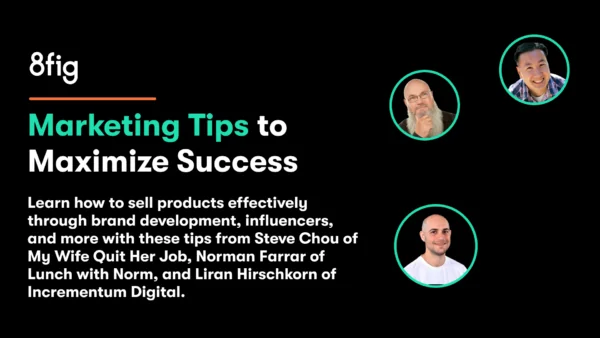Marketing is how most eCommerce founders drive qualified leads to their products and earn revenue. From TikTok influencers to personalized SMS campaigns, each brand must develop its own combination of strategies to sell their products effectively.
But a marketer’s work is never done and as trends and consumer habits change, good marketing adapts with it. We sat down with marketing experts in both the DTC and Amazon space to learn how to sell products effectively through brand development, influencers, and more. Check out these tips from Steve Chou of My Wife Quit Her Job, Norman Farrar of Lunch with Norm, and Liran Hirschkorn of Incrementum Digital.
In this blog we’ll cover how to:
- Get inspiration through community-building
- Impress with packaging and brand photography
- Continually optimize your product marketing
- Nurture existing customers just as much as new leads
- Build consistency in your marketing practices
- Target the right traffic on Google and Amazon
Keep reading to learn more or watch the full webinar on YouTube.
1. Get Inspiration Through Community-Building
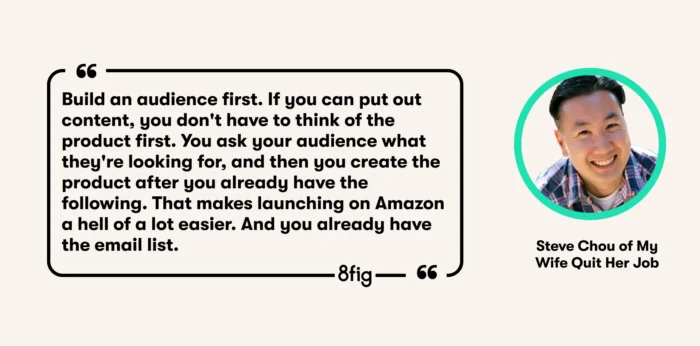
Did you know that conversion rates are more than 5x as high for businesses that adopt a content marketing strategy than those who don’t? Consumers now crave an emotional interaction with brands they purchase from and creating quality content and building an online community are two great ways to engage.
Steve Chou of My Wife Quit Her Job says community building can be the first step in launching a successful eCommerce brand: “Build an audience first. If you can put out content, you don’t have to think of the product first. You ask your audience what they’re looking for, and then you create the product after you already have the following. That makes launching on Amazon a hell of a lot easier. And you already have the email list.”
Here are some ways to build an authentic brand community:
- Invest in paid ads to engage newsletter signups
- Create active social media channels
- Launch an informational podcast or Youtube channel
- Let people vote on product features before it goes to market
- Run surveys to your audience to get insights and data
Steve’s favorite content platform is TikTok because of the lifetime value of the videos. “I have TikTok’s that are still getting traffic six months to a year later. Where’s Instagram? You might go viral, but it only lasts two days or three days.”
For more tips on how to build a community around your product, check out these expert tips on scaling with product innovation.
2. Impress with Packaging and Brand Photography
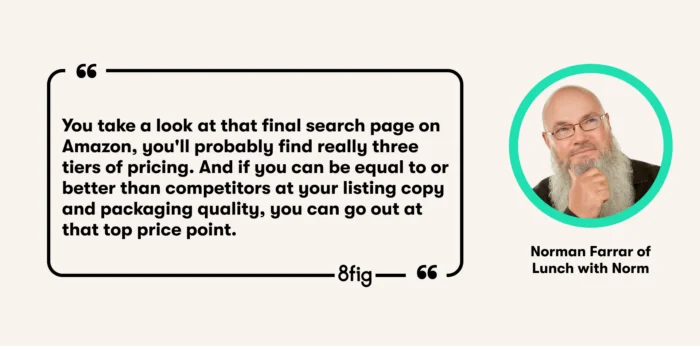
If you want to price your product in the top tier in order to generate more revenue, your brand has got to look the part. Consumers will be comparing your listing against competitors, and if your packaging and brand photography doesn’t reflect high-quality, they won’t pay extra for it.
If you’re selling your product on Amazon or another online marketplace, do research by plugging in your product keyword and analyzing the top page result. ““You take a look at that final search page on Amazon, you’ll probably find really three tiers of pricing. And if you can be equal to or better than competitors at your listing copy and packaging quality, you can go out at that top price point,” Norman Farrar explains.
Remember that if you’ve done the work to set your product apart, you shouldn’t be afraid to price high. “A lot of new sellers are afraid to come out at a higher price point, so they bottom feed, and they have to do lots of volume to be profitable,” Norm Farrar said.
You should also invest in the unboxing experience so consumers are just as excited about your product in real life as they are online. This is especially true for luxurious items or items with high return rates, such as retail.
3. Continually Optimize Your Product Marketing
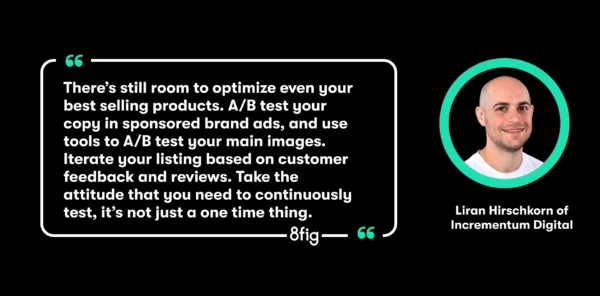
When it comes to marketing, your work is never done. This is true for new products and your best sellers because messaging that resonated with users 6 months ago may not have the same effect now. From product copy to brand photography ad campaigns and more, continually testing lets you learn what your customers are most excited to engage in every area of marketing.
“There’s still room to optimize even your best selling products,” Liran Hirschkorn of Incrementum Digital said. “Split test your copy in sponsored brand ads, and use tools to A/B test your main images. Iterate your listing based on customer feedback and reviews. Take the attitude that you need to continuously test, it’s not just a one time thing.”
Here are ways you can test your marketing:
- Read and learn from your reviews
- Pay attention to competitor reviews, too
- Ask your community for feedback
- A/B test product photos and copy
- Use samples to test products before new launches
There are even more ways to use data to identify marketing opportunities. For example, if you’re getting a significant number of impressions but not enough clicks you should try revising your messaging. Read more insights from eCommerce experts on how to leverage data to scale with confidence.
4. Nurture Existing Customers Just as Much as New Leads
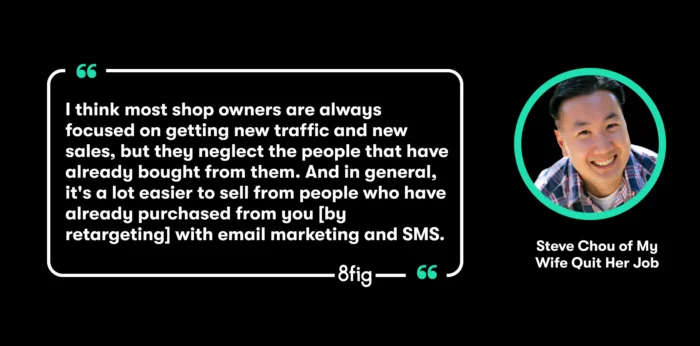
Scaling with new customers is great for business, but turning them into repeat customers is even better (and cheaper). Building brand loyalty into your marketing strategy increases customer retention and drives a sales increase of 25% to 95%.
“I think most shop owners are always focused on getting new traffic and new sales, but they neglect the people that have already bought from them. And in general, it’s a lot easier to sell from people who have already purchased from you [by retargeting] with email marketing and SMS,” Steve Chou of My Wife Quit Her Job explains.
Loyalty programs and personalization go a long way in making your returning customer excited about your brand. Use data to understand the type of products they engage with most on your site and send personalized texts and emails with coupons for those items. Voila! Your customer will feel seen and understood by a brand they already know and like.
You can harness this returning customer strategy even if your product isn’t something customers buy on repeat. Steve Chou is in the wedding business, meaning most customers only need his products once — except for the customers who buy his items in bulk.
“We look for customers who buy an unusually large number of our wedding products,” Steve Chou said. “We discovered that these people tend to be event planners and wedding planners. So we reach out to them via the phone and say ‘hey, we just noticed you bought a lot. If you’re a planner, we’ll give you a dedicated rep, a special coupon code and we’ll make sure anything that you want to make it on time, we’ll have a human on it.”
5. Build Consistency So You Can Automate and Scale
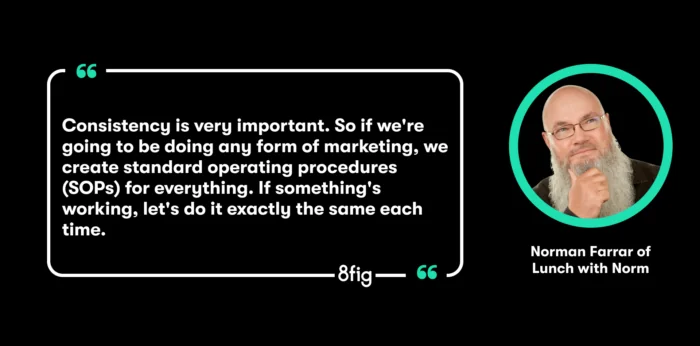
There’s a delicate balance between adapting to changing consumer habits and zeroing in on tried and true marketing tactics that every marketer must find. Investing in what does work and developing consistent marketing around that will drive sales and produce clean data you can constantly learn from.
Building standard operating procedures for the marketing tactics you do over and over again helps automate your strategy. “Consistency is very important,” Norman Farrar advises. “So if we’re going to be doing any form of marketing, we create standard operating procedures (SOPs) for everything. If something’s working, let’s do it exactly the same each time.”
Creating SOP’s also means you get consistency as new team members, such as a virtual assistant, are added. “You can’t just hire and expect the VA to run seamlessly on their own, you need to have systems and processes and training and onboarding,” Steve Chou explains. “Also if you paid a little bit higher rates, you’d get better quality people… and really focusing on hiring around a specific focus makes a lot of sense.”
6. Target the Right Traffic on Google and Amazon
It’s easy to get caught up in the hottest new marketing trend, but knowing where to invest your marketing energy to reach your target audience is essential to success. Sit down and look at which tools and platforms are bringing in money today and focus on optimizing your efforts there.
“I would find out what’s working and double down on it until you’ve saturated that traffic source or Acquisition Source,” said Steve Chou. ““Google and SEO is where our biggest customers are at. Just this year, we’re up almost between 3X-4X of our traffic by focusing on what’s already working.”
For Amazon and Google, you need to identify and target the right keywords and to optimize your content in order to rank for those. Be honest with yourself about what terms you can realistically rank for based on keyword difficulty and where you’re currently at in your business.
“I think keyword research is an incredibly important part of getting the right traffic on Amazon,” Liran Hirschkorn of Incrementum Digital said. “So using the right tools, understanding what the competitors are ranking for, and doing a good job of targeting the right keywords in your title and your backend search terms [are all important].”
Excited to scale your marketing after reading the above tips? We’d love to fund your new strategy!
8fig is a supply chain planning and funding solution for eCommerce sellers. We infuse continuous capital at every stage of the supply chain, including marketing. Sign up for a free 8fig Growth Plan today.
to our blog
Read the latest
from 8fig

From AI-powered styling to virtual try-ons, learn about the innovations transforming the fashion industry and enhancing the shopping experience.

Explore the pros and cons of lump sum loans vs. just-in-time funding, and discover why JIT funding could be the game-changer your eCommerce business needs.
![BFCM: The ultimate guide to eCommerce sales [2024]](https://www.8fig.co/wp-content/uploads/2023/09/cover-2-768x432.jpg.webp)
Get ready for Black Friday and Cyber Monday with our guide on maximizing sales through smart inventory management, effective marketing strategies, and leveraging eCommerce financing.
